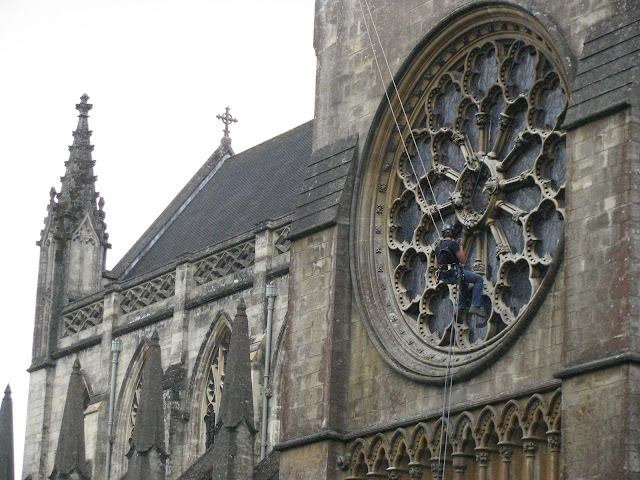We were commissioned by Beech Tyldesley Architects to carry out a condition report to certain areas of the Abbey via the means of rope access.
As part of the survey, we carried out a series of different cleaning samples to the stonework. For these samples we used a few different techniques in a few different areas on the building to see the variation of success.
For the areas of stonework where a build up of black/carbon was not present we found that a mechanical clean using stainless steel wire brushes and warm water worked really well. The crocket on this north aisle pinnacle below shows just how well!
It was amazing to see the difference it made to the detail of the carving. Up close you can see the detail and shadow intended, which from a distance we dont really get to appreciate.
In other areas there were quite heavy build ups of carbon on the underside of features such as grotesques, string courses and niches for the statues. Below is a before and after photo of the carbon build up on an east facing statue base. The method used for the trial was an ammonium carbonate poultice.
After the poultice is applied, it is covered in order to keep the moisture in. We then leave it on over night for the ammonium to do its magic. The next day it is then removed and cleaned off using a wire brush and water. This particular trial area shows fantastic results after just one application.
Below is a good picture of John Fowler applying the poultice over looking Downside school.
The statues themselves were not found in the best of states. Here is a picture of the statue central on the east elevation of the nave.
Beneath the obvious build up of vegetation and mosses, the stone is found to be in need of surface repairs.
Unfortunately, above the crown of this statue is a water escape route, possibly due to a failed section of string course.
The damage of which can be seen below.
As well as the poultice traials, the mechanical cleaning trails and the latex cleaning trials internally, we also carried out areas of cleaning using Restorative Techniques 'ThermaTech'. Can be found on twitter as @restorativetech
Quote from their website.
'ThermaTech® is a brand new range of superheated water cleaning equipment. Conceived for the requirements of building conservation, restoration and refurbishment'
I think its fantastic.
I carried out some of the trials using this machine from ropes. Here is picture of one of the gargoyles being cleaned.
And some samples were done a little lower down!
Parapet wall:
Litchen covered buttress:
A flying buttress:
All trials had very sucessful results using the Thermatech.
Some of the level of detailed carving found at high level was stunning. I found this gargoyle underneath a thick layer of moss!
So thats about it for now.
Below are a few more pictures that i hope you all find interesting.
Here I am in the vaulted ceiling internally checking out the condition of the stonework.
John and I checking out the amazing success of the ThermaTech machine.
John taking detail of condition on the north facing rose window.
John checking out the rose window internally.
Myself, James Preston (left), Jamie Fairchild of Restorative Techniques (middle) and Architect, Mark Taylor of Beech Tyldesley Architects (right)

















